Whether it’s happening in the hallway or over the phone, hurting someone else repeatedly with words or actions is bullying. When this happens online through social media, it’s called cyberbullying.
Teasing or pushing around others is never justified, no matter the situation. But bullying happens everywhere—and to more people than you may think. More than one-fifth of U.S. students report being bullied, according to the National Center for Education Statistics.
Many people are trying to reduce bullying. The PACER Center in Minneapolis, Minnesota, has run the National Bullying Prevention Center since 2006. The center teaches students, parents, and schools about the effects of bullying. “Bullying is an issue that impacts all kids,” says Bailey Lindgren of PACER. Often, kids are bullied for things that make them different from others.
Studies have found that bullying prevention programs can decrease bullying by 20 percent. PACER also encourages schools to prevent bullying by promoting kindness.
Natalie Hampton, 18, spent most of seventh and eighth grade eating lunch solo, because she was being bullied. She decided to take action to help spread kindness at lunch. Two years ago Natalie launched a free app called Sit With Us, which helps students invite others to join their table in the school cafeteria.
“Lunch may seem like a small thing, but I believe that incremental steps to improve the overall dynamic of a school community can bring about change,” Natalie says.


